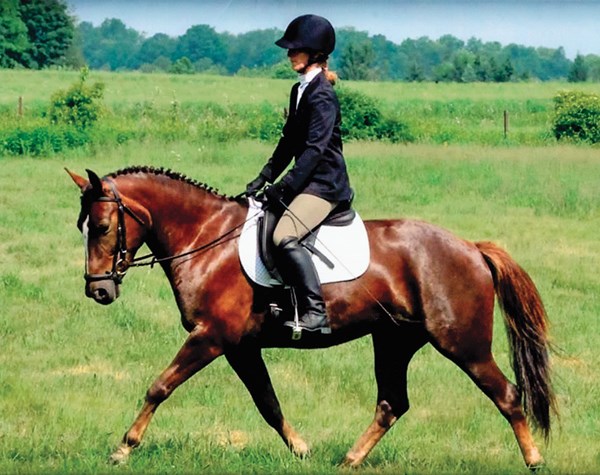
This picture shows Kimberley Reynolds on her 7-year-old Morgan–Haflinger-cross mare, Bella Luna. Kimberley and Luna both began their dressage journey together and they are showing now at First Level. She describes that even though Luna is only 15 hands, she has a huge heart.
This picture triggered many memories for me. I do have a soft spot for small horses with big hearts! When I was 14, I bred my own horse, who eventually grew up into my dream horse. But even a dream horse is not perfect and has, at least, one weakness or mistake. His weakness is that he was too small for me, which was the one thing that even nonriders would remark on the moment they saw me ride him. Next to my bed hung a drawing of Marc Todd showing his event mare named Charisma in dressage. Marc Todd is taller than I am, and Charisma was the same height as my little horse. And they won the Olympics…twice! I was extremely sensitive to the comment “isn’t he too small for you?” and I always argued that his heart was bigger than all the other horses I knew.
It looks lovely how balanced and fluid Luna is as she trots through the grass and appears to be in good harmony with her rider. Kimberley is sitting on her with a very light contact, and the picture gives the impression of deep trust and understanding between the two.
Luna’s stride is open and her backline looks truly supple. Her nose is slightly in front of the vertical with very nice neck carriage for First Level training. I do notice that Luna has a large jawbone, which does not allow a lot of room between her jaw and her neck. Many horses with this shape and angle between the jaw and neck can get tight and tense because the position of the head when working on the bit can create unwanted pressure. Kimberley is doing a good job of providing Luna with the necessary freedom she will need to perform in a supple position as she rides with light contact and allows her horse to reach for the bit. However, she does need to keep in mind that light contact does not always translate to a slack rein. Instead, Kimberley should aim toward maintaining a contact that is as light as the weight of the reins.
Kimberley is sitting with a slight forward tendency in her upper body, which causes her arms and hands to drop down a bit. I like her general balance and her leg position even though I think she can afford to let her stirrups down a few holes. Kimberley has enough body to allow her to ride with a long leg. Ideally, the length of the upper body and the legs should be equal. Kimberley clearly shows a longer upper body. Riding with short stirrups further exaggerates this. If she lengthens her stirrup, there will be more equal length in her upper and lower body. In dressage, we want our horses to work in positive tension. The rider needs to work with his or her body in this same positive tension which is possible only when the rider is able to lengthen his or her own body.
Luna is stretching her topline and opening her stride to appear as big as possible. Now Kimberley also needs to dare to be as proud. By opening more in her shoulders and stretching up through her spine she could shine with more confidence and help Luna to perform even better. It took me a long time to dare to sit tall on my small horse, and a very good instructor once told me to stop making my horse small or otherwise stay out of his lessons.
To feel how much influence the upper body can have on the expression of a horse’s gait, try this: Imagine you can sit in three different heights on the horse: short, medium and tall. Keep your head and your eyes looking straight while you change the length of your upper body. Do this rhythmically—for example, every three strides try to feel that stretching tall will encourage your horse, too, to carry herself more through her back.
A horse can become lighter in the forehand only if the rider is able to lift his own chest up. If you are afraid of becoming stiff while doing this, remember you must relax your upper body again after stretching it by returning to the middle position.
As you progress in your training, slightly stretching your upper body will become an aid for your horse to use her topline better. Every half halt, every transition and every corner should start with this lengthening in your spine. When you have practiced this enough to make this kind of motion more refined, you should be able to feel it clearly, but it should become less visible to someone watching.
With a little more lengthening in Kimberley’s upper body, I am positive that she will be able to ride with even more refined and light aids.
A tall upper body on a small horse is a huge lever, and it is very important to refine one’s feel for balance. With a good core stability, this will allow riding with very light aids and in good harmony. Kimberley, you can be very proud of your small “big” horse!
Susanne von Dietze is a leader in equestrian biomechanics. A physiotherapist, licensed Trainer A instructor and judge for dressage and show jumping, she gives lectures and seminars throughout the world, including at the prestigious German Riding Academy in Warendorf. She is a native of Germany and now lives with her husband and three children in Israel, where she competes at the international level. She is the author of two books on the biomechanics of riding: Balance in Movement and Horse and Rider, Back to Back. Find her books at HorseBooksEtc.com.











